Jerome Henry Brudos

A.K.A.: "The Lust Killer" - "Shoe Fetish Slayer"
Classification: Serial killer
Characteristics: Necrophiliac / Fetishist
Number of victims: 3 - 4
Date of murders: 1968 - 1969
Date of arrest: May 25, 1969
Date of birth: January 31, 1939
Victims profile: Linda Kay Slawson, 19 / Jan Susan Whitney, 23 / Karen Elena Sprinker, 19 / Linda Dawn Salee, 19
Method of murder: Strangulation
Location: Oregon, USA
Status: Pleads guilty to three counts of murder. Sentenced to three consecutive life sentences on June 27, 1969. Died in prison on March 28, 2006
Jerry Brudos, (31 January 1939 - 28 March 2006) was a serial killer and a necrophiliac also known as "The Lust Killer" and "Shoe Fetish Slayer".
Early life
Brudos was born in Webster, South Dakota. His mother had wanted a girl, and often ignored and belittled him. He had a fetish for women's shoes from the age of five. He spent his teen years in and out of psychotherapy and state hospitals. He began to stalk local women as a teenager, knocking down or choking them unconscious, and fleeing with their shoes.
At age 17, he dug a hole and kept girls as sex slaves. Shortly after he was found out and taken to a psychiatric ward of Oregon State Hospital for nine months. There it was found his sexual fantasies revolved around his hatred and revenge against his mother and women in general.
Brudos suppressed his obsessions long enough to graduate from high school and become an electronics technician. In 1961, he married and settled in a Portland, Oregon suburb. It was at about this time, however, that he began complaining of migraine headaches and "blackouts," relieving his symptoms with night-prowling raids to steal shoes and lace undergarments.
Murders
Between 1968 and 1969, Brudos bludgeoned and strangled four young women. The only initial evidence was witness sightings of a large man dressed in women's clothing. Brudos kept trophies from his victims, such as amputated breasts and a foot. After committing a murder, he would dress up in high heels and masturbate.
Police investigation and interviews of local coeds led them to Brudos, who confessed to the murders in detail. He was charged with three counts of murder and sentenced to life in prison.
Incarceration
While incarcerated, Brudos had piles of women's shoe catalogues in his cell — he wrote to major companies asking for them — and claimed they were his substitute for pornography. He lodged countless appeals, including one in which he alleged that a photograph taken of him with one of his victim's corpses cannot prove his guilt, as it is not the body of a person he was convicted of killing.
He died in prison in March 2006.
In popular culture
Brudos is the subject of the book Lust Killer by crime writer Ann Rule.
The American band Macabre made a song about Brudos, titled "Fatal Foot Fetish", which is featured on the 2003 album Murder Metal.
An American Deathcore band by the name of Through the Eyes of the Dead uses a quote by Jerry Brudos in the end of the song "Truest Shade of Crimson" off of their 2005 release "Bloodlust".
John Water's 1981 movie Polyester (film) portrays a disturbed teenager named Dexter Fishpaw with a serial foot stomping fetish. It is alluded that he uses pictures of shoes as a pornographic aid.
Board refuses parole for serial killer
August 19, 2005
An Oregon serial killer says he's getting more stable, but he won't be getting out of prison anytime soon.
Jerome Brudos has been in prison longer than any other person in Oregon. He was sent to prison back in 1969 for the torture murders of three women in the Salem area.
Brudos told the parole board he feels more stable after years of counseling. But the board has refused Brudos' request for parole.
Serial killer refuses to detail crimes
August 20, 2005
Salem's most notorious killer told a parole board Wednesday that he is recovering from colon cancer and pursuing his master's degree in counseling at the Oregon State Penitentiary.
Jerome Brudos, 66, has been locked up since 1969, longer than any other Oregon inmate.
Bald and portly, the serial killer said he is mellowing with age.
Three weeks ago, Brudos said, he avoided a prison altercation by walking away.
"I never would have done that" in past years, he said, drawing a distinction between his "hotheaded" past and his changed demeanor.
Mellowed or not, Brudos offered no new insight into his crimes. He declined to answer when a board member asked him why he committed the torture-murders that landed him behind bars for life.
Brudos indicated that the public session wasn't a suitable forum to delve into the matter.
"This is information I wanted to give to the board without it becoming public record or reading it in the newspaper," he said. "I have no intention of baring my soul."
No visitors attended Wednesday's proceeding of the state board of parole and post-prison supervision. The half-hour session officially was deemed a "personal interview" between Brudos and the board, not a parole hearing.
In 1995, the board voted to ban Brudos from ever getting parole. Since then, he has been allowed an interview with the board every two years.
It would take board action to grant Brudos a formal hearing. The three-member panel rejected such action Wednesday.
Board chairman Michael Washington told Brudos that he wouldn't receive a formal hearing, in part because of his refusal to candidly discuss his crimes.
Brudos pleaded guilty and was sentenced to three consecutive life sentences for killing three women in Salem: Jan Susan Whitney, Karen Elena Sprinker and Linda Dawn Salee.
Brudos abducted the women from public places and took them to his home near the Oregon State Hospital. When police searched his home, they found a collection of his photos, some showing victims hanging from a pulley. One of his victims choked to death after he used the contraption to lift her off the floor and left the room.
Investigators determined that Brudos sexually attacked his victims and mutilated them before dumping their bodies into area rivers.
Brudos also admitted to a fourth murder in Multnomah County, telling a psychiatrist that he killed a teenager who was selling encyclopedias door to door in Portland. Her body was not found, and he was not prosecuted in that case.
At the penitentiary, Brudos told the board Wednesday that he has benefited from 17 years of psychological treatment, as well as schooling and work programs.
"I'm more stable now than I ever was out on the streets," he said.
Brudos said that he accepts responsibility for his crimes but that he prefers not to dwell on what happened.
"I'm trying to get on with my life," he said.
Brudos said he has earned two college degrees behind bars, in general sciences and counseling.
"I'm working on a third," he said, citing his work toward a master's degree in counseling.
Brudos repeatedly criticized the past and present parole board. He said the board's 1995 decision to ban him from parole consideration was "an act of vengeance."
Federal court rulings have upheld the board's handling of Brudos' case, Washington said. The longtime convict gets an interview with the board every two years because the courts have held that he is entitled to the biennial meetings, he said.
Brudos says he is being deprived of his rights.
"This is not over," he said, handcuffed and waiting to return to his cell after meeting with the board. "They cannot remove my legal rights."
Asked about his health, Brudos said he underwent colon cancer surgery about a year ago. He had little to say about his prognosis or prison routines.
"One day's like another in here," he said.
Jerome Brudos timeline & Victims
29 march 2006
Key dates in the investigation and prosecution of Jerome Brudos.
Jan. 26, 1968: Linda Slawson, 19, of Aloha is last seen selling encyclopedias in the Portland neighborhood where Brudos lived with his wife, Ralphene, and their two kids. Slawson's body was never recovered, but Brudos later would tell police he killed her and threw her body into the Willamette River from the Wilsonville bridge on Interstate 5. Brudos never was prosecuted for her death.
Nov. 25, 1968: Jan Whitney, 23, of McMinnville is last seen in Eugene. Her car was later found abandoned at a rest stop along Interstate 5 between Salem and Albany.
March 27, 1969: Karen Sprinker, 19, of Salem is last seen alive in the Meier & Frank parking lot in downtown Salem.
April 22, 1969: Gloria Jean Smith, 15, is nearly abducted while walking near Parrish Middle School. Smith eventually identifies Brudos as the man who attempted to kidnap her and take her to a green Volkswagen Karmann Ghia, a car later identified as belonging to Brudos' mother. Before getting to the car, Smith spots Phyllis Kerr working in nearby front yard and yells to her and pulls away.
April 23, 1969: Linda Salee, 22, of Beaverton is last seen alive at the Lloyd Center parking lot in Portland.
May 10, 1969: The body of Linda Salee, 22, is found in the Long Tom River near Monroe, weighted down.
May 12, 1969: The body of Karen Elena Sprinker, 19, is found in the Long Tom River near Monroe, weighted down.
May 18, 1969: Jerome Brudos is identified as a possible suspect after a tip from an Oregon State University student.
May 26, 1969: Brudos' home in the 3100 block of Center Street NE is searched by police who find copper wire, rope and pictures of female victims.
May 29, 1969: Brudos is arrested on a charge of armed assault related to the April 22 incident with Gloria Smith.
June 3, 1969: Brudos is arrested in Salem on three counts of murder in the deaths of Karen Sprinker, Linda Salee and Jan Whitney.
June 27, 1969: Brudos pleads guilty to three counts of murder in the deaths of Sprinker, Salee and Whitney, three days before the scheduled start of a trial. Judge Val Sloper hands down three consecutive life sentences. Brudos is transferred to the Oregon State Penitentiary.
July 27, 1969: The body of Jan Whitney is found tied to a piece of railroad iron in the Willamette River near Independence.
June 21, 1995: After repeated parole hearings, the Oregon Parole Board tells Brudos he will never be paroled. "You will be in prison for the rest of your life, and there will be no further parole hearings," said board chair Marva Fabien. Brudos continues to be allowed to appear before parole board every two years for an informal interview.
March 28, 2006: Jerome Brudos dies at 5:10 a.m. inside the Oregon State Penitentiary.
Brudos' known victims
Jan Susan Whitney was the first of the three women whose deaths would be attributed to Jerome Brudos. The 23-year-old from McMinnville last was seen in Eugene on Nov. 25, 1968. Her car later was found abandoned at a rest area along Interstate 5 between Salem and Albany.
Karen Elena Sprinker of Salem, a 19-year-old honor student at Oregon State University, was killed in March 1969. Police suspected that she was abducted from the parking structure at Meier & Frank in downtown Salem, where she was to meet up with her mother for a lunch date.
Linda Dawn Salee, 19, of Beaverton worked as a secretary and attended classes part time at Portland State University. In April 1969, Salee's car was found at Lloyd Center in Portland, where she had gone to buy her boyfriend a birthday present.
Linda Kay Slawson, 19, of Aloha, last was seen in January 1968 selling encyclopedias door-to-door in Portland, where Brudos and his family lived at the time. Her body never was recovered, and Brudos never was prosecuted for her death.
Infamous murderer dies at 67 in prison
29 march 2006
Jerome Henry Brudos, a Salem electrician whose torture-murder of at least three young women in the late 1960s gave law enforcement nationwide fresh insight into the dark forces that create a serial killer, died Tuesday in the Oregon State Penitentiary. He was 67 and the state's longest-serving inmate.
The Oregon Department of Corrections released few details other than to say Brudos died at 5:10 a.m. in the prison infirmary. A relative of one of Brudos' victims said Tuesday she learned that he had suffered from liver cancer.
Brudos was serving three consecutive life sentences for the murders of Linda Dawn Salee, 22, of Beaverton; Karen Elena Sprinker, 19, of Salem; and Jan Susan Whitney, 23, of McMinnville. Brudos later confessed to the murders of Linda Slawson, 19, and Stephanie Vikko, 16, but police did not have enough physical evidence to charge him. At the time, Oregon did not have the death penalty.
"He was one of the true monsters of the United States or the world perhaps," said James Stovall, the Salem detective who tracked down Brudos.
Married with two children, Brudos either lured or kidnapped the young women, sometimes with a uniform and badge. He took them to the garage of his Salem house and, usually within an hour, strangled them.
He photographed the women as they died and after their deaths. He dressed their bodies in lingerie and had sex with them. He then cut off body parts. One foot he preserved and used to model his collection of high-heeled shoes. He cast a severed breast in resin for a paperweight.
Stovall and the Salem police got onto Brudos' trail in May 1969 when the bodies of Salee and Sprinker were found in the Long Tom River. Their bodies were weighted down with old automobile parts.
On Tuesday, Stovall said the break in the case came when Brudos tried to kidnap a 12-year-old girl. She escaped and identified him for police from a photo lineup. Brudos was arrested just ahead of the Memorial Day weekend, and through those three days, Stovall lived at the old City Hall as Brudos dropped hints.
Stovall said Brudos at first would profess innocence, then would ask, "So how would you know?"
"And I would tell him: 'There are things that you know, Jerry, and things that I know that nobody else knows.'
A confession
Finally, Brudos confessed. On June 27, 1969, three days before he was scheduled to go to trial, Brudos pleaded guilty to murdering Salee, Sprinker and Whitney.
Not long after, the Northwest correspondent for True Detective magazine arrived in Salem from Seattle. Long before she told the story of serial killer Theodore Bundy, Ann Rule studied Brudos.
"I can remember going out to the house on Center Street, scared to death, seeing the rose-covered trellises in the breezeway between the house and the garage," Rule said Tuesday.
At the time, law enforcement knew little about serial killers, Rule said, then, "the FBI behavioral science unit kind of chose Brudos as the perfect poster boy for lust murder, which is a step beyond serial murder because sexual torture is involved."
Rule and behavioral scientists studied Brudos' background. Born Jan. 31, 1939, in South Dakota, he was raised in California with a domineering mother who desperately had wanted a girl, so she dressed Brudos in girl's clothes. Still, he was treated as a family outcast.
Early fascination
At an early age, he apparently acquired a fascination with high-heeled shoes and started breaking into homes to steal them. The family moved to Oregon when Brudos was a teenager, and in 1956, he was sent to the Oregon State Hospital after he beat up a girl who rejected his advances.
He was in the Army for a short time but once back in Oregon, Brudos became an electrician. His raids into people's homes continued, and he had started preying on women, stalking them until he could knock them down and choke them to steal their shoes. He married, lived in Portland for a time, then moved to Salem.
"Serial killers almost never physically hurt someone they know," Rule said. "It has to be a stranger, a particular victim type. When they are in the killing mode, it is whoever happens to cross their path who fits the profile."
In 1982, Rule published "Lust Murder," a book about Brudos. She said that while nearly 40 years of study has yielded much information about serial killers, authorities still do not know a lot.
"If we could predict what causes them, we could stop them," she said.
Mixed emotions
While the story of Jerome Henry Brudos will live on in law enforcement texts and true-crime books, his death left mixed emotions Tuesday in Cindi Elliott Aurora, Jan Whitney's sister.
"Sad. Relieved," Elliott said. "I hope he spends all eternity in hell."
Elliott said she got the news Tuesday from a cousin, who had been notified by the Corrections Department. The cousin passed the news that Brudos had been suffering with liver cancer. All day, Elliott said, she wrestled with her feelings about Brudos.
"I wish I'd kinda known he was sick," she said. "Part of me would have, maybe, even talked to him. I'm not sure. I don't know what I would have expected having a conversation with him."
Her sister would have been 62 this year, Elliott said: "She would have been a grandmother."
Elliott was curious about one facet of Brudos' death.
"I did ask, 'What's happening to his body?' They told me, a friend had been listed as next of kin, so it will go to the friend. I was always curious about what would happen."
Bodies in the Long Tom
At first glance, Jerome Henry Brudos hardly fit the profile of a serial killer, the confessed murderer of three young Oregon women, and possibly a fourth who has never been found.
But a thorough investigation of Brudos' private life turned up some dark corners in the total picture of the supposedly mild-mannered, soft-spoken Salem man who was convicted and sentenced to life in the Oregon State Penitentiary for the strangulation deaths of Karen Sprinker, Linda Salee and Jan Whitney in late 1968 or early 1969.
Brudos had been committed to the Oregon State Hospital many years earlier after being taken into custody for threatening two girls and forcing them at knifepoint to disrobe so he could photograph them. He also was accused of stealing and wearing women's clothing, and Brudos later admitted he was wearing women's panties and pedal pushers when he staked out Sackett Hall, a girl's dormitory at the Oregon State University campus, looking for women.
One of his victims-- Karen Sprinker-was a student at Oregon State. The 19 year-old coed was supposed to meet her mother for lunch at the Meier & Frank Department Store in downtown Salem on March 27, 1969. But she never showed up.
Her car was found locked and abandoned on the store's rooftop parking lot later, but there was no trace of the girl.
About a month later, Linda Salee, 22, of Portland, disappeared while shopping at Portland's Lloyd Center Shopping Center for a birthday gift for her boyfriend. She was last seen walking out of a jewelry shop at about 5:30 p.m. that day. Her car was found later in the Lloyd Center parking garage where she had parked it on her arrival at the shopping center.
Sprinker and Salee joined a list of several young Oregon women who had mysteriously vanished during 1968 and 1969. One other name on the list was Jan Susan Whimey, a 23-year-old McMinnville woman who disappeared Nov. 26, 1968. Her car was located at a rest stop along the Interstate 5 freeway, just north of Albany.
Another missing girl was 19-year-old Linda K. Slawson, of Aloha, who was selling encyclopedias in a section of Portland when she vanished on Jan. 26, 1968. Brudos later would be charged with her murder.
Law enforcement agencies throughout Marion, Benton and Multnomah counties, as well as the FBI, had been searching for months to find any kind of lead on the missing women when a lone fisherman stumbled across the biggest find of his life. Sam Wallace had been looking for a fishing spot along the Long Tom River, 12 miles south of Corvallis, on May 10, 1969, when he spotted something unusual floating near the surface of the water. Looking closer, he discovered it was a human body. Wallace raced to his car and drove to the nearest gas station to call police.
Benton County Sheriff's deputies hurried to the river. The body had been tied, by nylon cord and copper wire, to a heavy automobile transmission and dumped into the fiver. Deputies removed the victim and later discovered she was Linda Salee, the Portland girl who had disappeared from Lloyd Center. On a hunch there may be more bodies nearby, reserve sheriff's divers dragged the river. Two days later, they found the body of Karen Sprinker -- only about 50 feet from where Salee's body was found. Sprinker's body also was weighted down, with the head of a 6-cylinder car engine. Nylon cord was used to tie the body to the engine.
Both victims were partially clothed when found. On April 22 -- the same day Linda Salee disappeared from Lloyd Center in Portland, a 15-year-old Salem girl on her way home from school was accosted by a man with a plastic gun who tried to force her into his car. The girl managed to break away from the man, who apparently panicked, climbed into his car and drove off.
That report was still on investigators' minds when they learned May 14 that an Oregon State coed had received a phone call from a man who identified himself as a Vietnam veteran. The man said he had learned a new method of study while he was a patient at Walter Reed Medical Center and asked if she would like to meet him to discuss it. She consented, but then became suspicious of the vet's intentions, especially after he told her he couldn't meet her for a date because he had to change the motor of his car. She called Corvallis Police detectives.
They suggested the coed accept a date with the man and meet him at her dorm on campus. They would be waiting when he arrived.
When the man arrived, detectives hustled him into a room and began questioning him.
Within a week, Marion County District Attorney Gary Gortmaker announced that Jerome H. Brudos, a 30-year-old Salem electrician, had been charged with four counts of first-degree murder. But the Grand Jury, meeting June 4, indicted Brudos on only one count of first-degree murder, in the death of Karen Sprinker. Brudos pleaded innocent by reason of insanity.
It was later revealed, in an affidavit authorizing a search of Brudos' Salem home, that wire identical to the wire used to tie the victims to the car parts was found inside the residence, along with photos of nude and clothed women, women's clothes and lists of women's names, addresses and phone numbers. There were also notes on all sororities and women's living organizations at Oregon State. Some women on the list reportedly told police they received phone calls from a man claiming to be a Vietnam veteran and said he was lonely. Some said they even dated the man.
At the time of his arrest, Brudos was married and the father of two. Some of his friends described him as a devoted family man, who neither drank nor smoked, and rarely if ever used profanity.
Three days before he was scheduled to go to trial for the Sprinker murder, Brudos changed his plea to guilty to the three original murder charges, in the deaths of Karen Sprinker, Jan Whitney and Linda Salee. Brudos told Marion County Circuit Judge Val D. Sloper he strangled Sprinker with a rope and used a leather strap to strangle Whitney and Salee.
Sloper then sentenced Brudos to three consecutive life sentences in the Oregon State

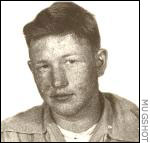
Jerry Brudos at 17

Jerry Brudos
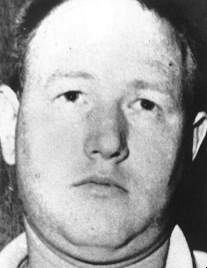
Jerry Brudos
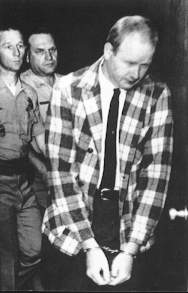
Jerry Brudos
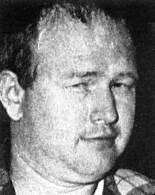
Jerry Brudos

Jerry Brudos
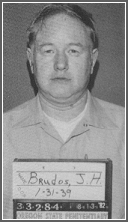
Jerry Brudos
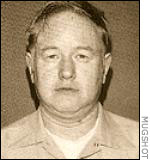
Jerry Brudos
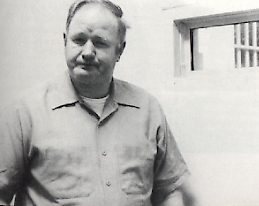
Jerry Brudos
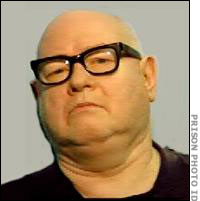
Jerry Brudos


Rope and knot samples.
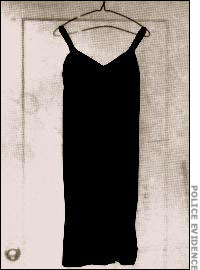
Nightgown worn by victims.

Brudo's wife.
Victims
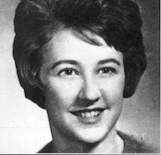
Jan Whitney

Karen Sprinker
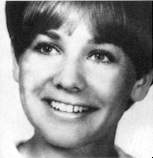
Linda Salee
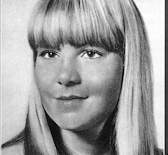
Linda Slawson

A.K.A.: "The Lust Killer" - "Shoe Fetish Slayer"
Classification: Serial killer
Characteristics: Necrophiliac / Fetishist
Number of victims: 3 - 4
Date of murders: 1968 - 1969
Date of arrest: May 25, 1969
Date of birth: January 31, 1939
Victims profile: Linda Kay Slawson, 19 / Jan Susan Whitney, 23 / Karen Elena Sprinker, 19 / Linda Dawn Salee, 19
Method of murder: Strangulation
Location: Oregon, USA
Status: Pleads guilty to three counts of murder. Sentenced to three consecutive life sentences on June 27, 1969. Died in prison on March 28, 2006
Jerry Brudos, (31 January 1939 - 28 March 2006) was a serial killer and a necrophiliac also known as "The Lust Killer" and "Shoe Fetish Slayer".
Early life
Brudos was born in Webster, South Dakota. His mother had wanted a girl, and often ignored and belittled him. He had a fetish for women's shoes from the age of five. He spent his teen years in and out of psychotherapy and state hospitals. He began to stalk local women as a teenager, knocking down or choking them unconscious, and fleeing with their shoes.
At age 17, he dug a hole and kept girls as sex slaves. Shortly after he was found out and taken to a psychiatric ward of Oregon State Hospital for nine months. There it was found his sexual fantasies revolved around his hatred and revenge against his mother and women in general.
Brudos suppressed his obsessions long enough to graduate from high school and become an electronics technician. In 1961, he married and settled in a Portland, Oregon suburb. It was at about this time, however, that he began complaining of migraine headaches and "blackouts," relieving his symptoms with night-prowling raids to steal shoes and lace undergarments.
Murders
Between 1968 and 1969, Brudos bludgeoned and strangled four young women. The only initial evidence was witness sightings of a large man dressed in women's clothing. Brudos kept trophies from his victims, such as amputated breasts and a foot. After committing a murder, he would dress up in high heels and masturbate.
Police investigation and interviews of local coeds led them to Brudos, who confessed to the murders in detail. He was charged with three counts of murder and sentenced to life in prison.
Incarceration
While incarcerated, Brudos had piles of women's shoe catalogues in his cell — he wrote to major companies asking for them — and claimed they were his substitute for pornography. He lodged countless appeals, including one in which he alleged that a photograph taken of him with one of his victim's corpses cannot prove his guilt, as it is not the body of a person he was convicted of killing.
He died in prison in March 2006.
In popular culture
Brudos is the subject of the book Lust Killer by crime writer Ann Rule.
The American band Macabre made a song about Brudos, titled "Fatal Foot Fetish", which is featured on the 2003 album Murder Metal.
An American Deathcore band by the name of Through the Eyes of the Dead uses a quote by Jerry Brudos in the end of the song "Truest Shade of Crimson" off of their 2005 release "Bloodlust".
John Water's 1981 movie Polyester (film) portrays a disturbed teenager named Dexter Fishpaw with a serial foot stomping fetish. It is alluded that he uses pictures of shoes as a pornographic aid.
Board refuses parole for serial killer
August 19, 2005
An Oregon serial killer says he's getting more stable, but he won't be getting out of prison anytime soon.
Jerome Brudos has been in prison longer than any other person in Oregon. He was sent to prison back in 1969 for the torture murders of three women in the Salem area.
Brudos told the parole board he feels more stable after years of counseling. But the board has refused Brudos' request for parole.
Serial killer refuses to detail crimes
August 20, 2005
Salem's most notorious killer told a parole board Wednesday that he is recovering from colon cancer and pursuing his master's degree in counseling at the Oregon State Penitentiary.
Jerome Brudos, 66, has been locked up since 1969, longer than any other Oregon inmate.
Bald and portly, the serial killer said he is mellowing with age.
Three weeks ago, Brudos said, he avoided a prison altercation by walking away.
"I never would have done that" in past years, he said, drawing a distinction between his "hotheaded" past and his changed demeanor.
Mellowed or not, Brudos offered no new insight into his crimes. He declined to answer when a board member asked him why he committed the torture-murders that landed him behind bars for life.
Brudos indicated that the public session wasn't a suitable forum to delve into the matter.
"This is information I wanted to give to the board without it becoming public record or reading it in the newspaper," he said. "I have no intention of baring my soul."
No visitors attended Wednesday's proceeding of the state board of parole and post-prison supervision. The half-hour session officially was deemed a "personal interview" between Brudos and the board, not a parole hearing.
In 1995, the board voted to ban Brudos from ever getting parole. Since then, he has been allowed an interview with the board every two years.
It would take board action to grant Brudos a formal hearing. The three-member panel rejected such action Wednesday.
Board chairman Michael Washington told Brudos that he wouldn't receive a formal hearing, in part because of his refusal to candidly discuss his crimes.
Brudos pleaded guilty and was sentenced to three consecutive life sentences for killing three women in Salem: Jan Susan Whitney, Karen Elena Sprinker and Linda Dawn Salee.
Brudos abducted the women from public places and took them to his home near the Oregon State Hospital. When police searched his home, they found a collection of his photos, some showing victims hanging from a pulley. One of his victims choked to death after he used the contraption to lift her off the floor and left the room.
Investigators determined that Brudos sexually attacked his victims and mutilated them before dumping their bodies into area rivers.
Brudos also admitted to a fourth murder in Multnomah County, telling a psychiatrist that he killed a teenager who was selling encyclopedias door to door in Portland. Her body was not found, and he was not prosecuted in that case.
At the penitentiary, Brudos told the board Wednesday that he has benefited from 17 years of psychological treatment, as well as schooling and work programs.
"I'm more stable now than I ever was out on the streets," he said.
Brudos said that he accepts responsibility for his crimes but that he prefers not to dwell on what happened.
"I'm trying to get on with my life," he said.
Brudos said he has earned two college degrees behind bars, in general sciences and counseling.
"I'm working on a third," he said, citing his work toward a master's degree in counseling.
Brudos repeatedly criticized the past and present parole board. He said the board's 1995 decision to ban him from parole consideration was "an act of vengeance."
Federal court rulings have upheld the board's handling of Brudos' case, Washington said. The longtime convict gets an interview with the board every two years because the courts have held that he is entitled to the biennial meetings, he said.
Brudos says he is being deprived of his rights.
"This is not over," he said, handcuffed and waiting to return to his cell after meeting with the board. "They cannot remove my legal rights."
Asked about his health, Brudos said he underwent colon cancer surgery about a year ago. He had little to say about his prognosis or prison routines.
"One day's like another in here," he said.
Jerome Brudos timeline & Victims
29 march 2006
Key dates in the investigation and prosecution of Jerome Brudos.
Jan. 26, 1968: Linda Slawson, 19, of Aloha is last seen selling encyclopedias in the Portland neighborhood where Brudos lived with his wife, Ralphene, and their two kids. Slawson's body was never recovered, but Brudos later would tell police he killed her and threw her body into the Willamette River from the Wilsonville bridge on Interstate 5. Brudos never was prosecuted for her death.
Nov. 25, 1968: Jan Whitney, 23, of McMinnville is last seen in Eugene. Her car was later found abandoned at a rest stop along Interstate 5 between Salem and Albany.
March 27, 1969: Karen Sprinker, 19, of Salem is last seen alive in the Meier & Frank parking lot in downtown Salem.
April 22, 1969: Gloria Jean Smith, 15, is nearly abducted while walking near Parrish Middle School. Smith eventually identifies Brudos as the man who attempted to kidnap her and take her to a green Volkswagen Karmann Ghia, a car later identified as belonging to Brudos' mother. Before getting to the car, Smith spots Phyllis Kerr working in nearby front yard and yells to her and pulls away.
April 23, 1969: Linda Salee, 22, of Beaverton is last seen alive at the Lloyd Center parking lot in Portland.
May 10, 1969: The body of Linda Salee, 22, is found in the Long Tom River near Monroe, weighted down.
May 12, 1969: The body of Karen Elena Sprinker, 19, is found in the Long Tom River near Monroe, weighted down.
May 18, 1969: Jerome Brudos is identified as a possible suspect after a tip from an Oregon State University student.
May 26, 1969: Brudos' home in the 3100 block of Center Street NE is searched by police who find copper wire, rope and pictures of female victims.
May 29, 1969: Brudos is arrested on a charge of armed assault related to the April 22 incident with Gloria Smith.
June 3, 1969: Brudos is arrested in Salem on three counts of murder in the deaths of Karen Sprinker, Linda Salee and Jan Whitney.
June 27, 1969: Brudos pleads guilty to three counts of murder in the deaths of Sprinker, Salee and Whitney, three days before the scheduled start of a trial. Judge Val Sloper hands down three consecutive life sentences. Brudos is transferred to the Oregon State Penitentiary.
July 27, 1969: The body of Jan Whitney is found tied to a piece of railroad iron in the Willamette River near Independence.
June 21, 1995: After repeated parole hearings, the Oregon Parole Board tells Brudos he will never be paroled. "You will be in prison for the rest of your life, and there will be no further parole hearings," said board chair Marva Fabien. Brudos continues to be allowed to appear before parole board every two years for an informal interview.
March 28, 2006: Jerome Brudos dies at 5:10 a.m. inside the Oregon State Penitentiary.
Brudos' known victims
Jan Susan Whitney was the first of the three women whose deaths would be attributed to Jerome Brudos. The 23-year-old from McMinnville last was seen in Eugene on Nov. 25, 1968. Her car later was found abandoned at a rest area along Interstate 5 between Salem and Albany.
Karen Elena Sprinker of Salem, a 19-year-old honor student at Oregon State University, was killed in March 1969. Police suspected that she was abducted from the parking structure at Meier & Frank in downtown Salem, where she was to meet up with her mother for a lunch date.
Linda Dawn Salee, 19, of Beaverton worked as a secretary and attended classes part time at Portland State University. In April 1969, Salee's car was found at Lloyd Center in Portland, where she had gone to buy her boyfriend a birthday present.
Linda Kay Slawson, 19, of Aloha, last was seen in January 1968 selling encyclopedias door-to-door in Portland, where Brudos and his family lived at the time. Her body never was recovered, and Brudos never was prosecuted for her death.
Infamous murderer dies at 67 in prison
29 march 2006
Jerome Henry Brudos, a Salem electrician whose torture-murder of at least three young women in the late 1960s gave law enforcement nationwide fresh insight into the dark forces that create a serial killer, died Tuesday in the Oregon State Penitentiary. He was 67 and the state's longest-serving inmate.
The Oregon Department of Corrections released few details other than to say Brudos died at 5:10 a.m. in the prison infirmary. A relative of one of Brudos' victims said Tuesday she learned that he had suffered from liver cancer.
Brudos was serving three consecutive life sentences for the murders of Linda Dawn Salee, 22, of Beaverton; Karen Elena Sprinker, 19, of Salem; and Jan Susan Whitney, 23, of McMinnville. Brudos later confessed to the murders of Linda Slawson, 19, and Stephanie Vikko, 16, but police did not have enough physical evidence to charge him. At the time, Oregon did not have the death penalty.
"He was one of the true monsters of the United States or the world perhaps," said James Stovall, the Salem detective who tracked down Brudos.
Married with two children, Brudos either lured or kidnapped the young women, sometimes with a uniform and badge. He took them to the garage of his Salem house and, usually within an hour, strangled them.
He photographed the women as they died and after their deaths. He dressed their bodies in lingerie and had sex with them. He then cut off body parts. One foot he preserved and used to model his collection of high-heeled shoes. He cast a severed breast in resin for a paperweight.
Stovall and the Salem police got onto Brudos' trail in May 1969 when the bodies of Salee and Sprinker were found in the Long Tom River. Their bodies were weighted down with old automobile parts.
On Tuesday, Stovall said the break in the case came when Brudos tried to kidnap a 12-year-old girl. She escaped and identified him for police from a photo lineup. Brudos was arrested just ahead of the Memorial Day weekend, and through those three days, Stovall lived at the old City Hall as Brudos dropped hints.
Stovall said Brudos at first would profess innocence, then would ask, "So how would you know?"
"And I would tell him: 'There are things that you know, Jerry, and things that I know that nobody else knows.'
A confession
Finally, Brudos confessed. On June 27, 1969, three days before he was scheduled to go to trial, Brudos pleaded guilty to murdering Salee, Sprinker and Whitney.
Not long after, the Northwest correspondent for True Detective magazine arrived in Salem from Seattle. Long before she told the story of serial killer Theodore Bundy, Ann Rule studied Brudos.
"I can remember going out to the house on Center Street, scared to death, seeing the rose-covered trellises in the breezeway between the house and the garage," Rule said Tuesday.
At the time, law enforcement knew little about serial killers, Rule said, then, "the FBI behavioral science unit kind of chose Brudos as the perfect poster boy for lust murder, which is a step beyond serial murder because sexual torture is involved."
Rule and behavioral scientists studied Brudos' background. Born Jan. 31, 1939, in South Dakota, he was raised in California with a domineering mother who desperately had wanted a girl, so she dressed Brudos in girl's clothes. Still, he was treated as a family outcast.
Early fascination
At an early age, he apparently acquired a fascination with high-heeled shoes and started breaking into homes to steal them. The family moved to Oregon when Brudos was a teenager, and in 1956, he was sent to the Oregon State Hospital after he beat up a girl who rejected his advances.
He was in the Army for a short time but once back in Oregon, Brudos became an electrician. His raids into people's homes continued, and he had started preying on women, stalking them until he could knock them down and choke them to steal their shoes. He married, lived in Portland for a time, then moved to Salem.
"Serial killers almost never physically hurt someone they know," Rule said. "It has to be a stranger, a particular victim type. When they are in the killing mode, it is whoever happens to cross their path who fits the profile."
In 1982, Rule published "Lust Murder," a book about Brudos. She said that while nearly 40 years of study has yielded much information about serial killers, authorities still do not know a lot.
"If we could predict what causes them, we could stop them," she said.
Mixed emotions
While the story of Jerome Henry Brudos will live on in law enforcement texts and true-crime books, his death left mixed emotions Tuesday in Cindi Elliott Aurora, Jan Whitney's sister.
"Sad. Relieved," Elliott said. "I hope he spends all eternity in hell."
Elliott said she got the news Tuesday from a cousin, who had been notified by the Corrections Department. The cousin passed the news that Brudos had been suffering with liver cancer. All day, Elliott said, she wrestled with her feelings about Brudos.
"I wish I'd kinda known he was sick," she said. "Part of me would have, maybe, even talked to him. I'm not sure. I don't know what I would have expected having a conversation with him."
Her sister would have been 62 this year, Elliott said: "She would have been a grandmother."
Elliott was curious about one facet of Brudos' death.
"I did ask, 'What's happening to his body?' They told me, a friend had been listed as next of kin, so it will go to the friend. I was always curious about what would happen."
Bodies in the Long Tom
At first glance, Jerome Henry Brudos hardly fit the profile of a serial killer, the confessed murderer of three young Oregon women, and possibly a fourth who has never been found.
But a thorough investigation of Brudos' private life turned up some dark corners in the total picture of the supposedly mild-mannered, soft-spoken Salem man who was convicted and sentenced to life in the Oregon State Penitentiary for the strangulation deaths of Karen Sprinker, Linda Salee and Jan Whitney in late 1968 or early 1969.
Brudos had been committed to the Oregon State Hospital many years earlier after being taken into custody for threatening two girls and forcing them at knifepoint to disrobe so he could photograph them. He also was accused of stealing and wearing women's clothing, and Brudos later admitted he was wearing women's panties and pedal pushers when he staked out Sackett Hall, a girl's dormitory at the Oregon State University campus, looking for women.
One of his victims-- Karen Sprinker-was a student at Oregon State. The 19 year-old coed was supposed to meet her mother for lunch at the Meier & Frank Department Store in downtown Salem on March 27, 1969. But she never showed up.
Her car was found locked and abandoned on the store's rooftop parking lot later, but there was no trace of the girl.
About a month later, Linda Salee, 22, of Portland, disappeared while shopping at Portland's Lloyd Center Shopping Center for a birthday gift for her boyfriend. She was last seen walking out of a jewelry shop at about 5:30 p.m. that day. Her car was found later in the Lloyd Center parking garage where she had parked it on her arrival at the shopping center.
Sprinker and Salee joined a list of several young Oregon women who had mysteriously vanished during 1968 and 1969. One other name on the list was Jan Susan Whimey, a 23-year-old McMinnville woman who disappeared Nov. 26, 1968. Her car was located at a rest stop along the Interstate 5 freeway, just north of Albany.
Another missing girl was 19-year-old Linda K. Slawson, of Aloha, who was selling encyclopedias in a section of Portland when she vanished on Jan. 26, 1968. Brudos later would be charged with her murder.
Law enforcement agencies throughout Marion, Benton and Multnomah counties, as well as the FBI, had been searching for months to find any kind of lead on the missing women when a lone fisherman stumbled across the biggest find of his life. Sam Wallace had been looking for a fishing spot along the Long Tom River, 12 miles south of Corvallis, on May 10, 1969, when he spotted something unusual floating near the surface of the water. Looking closer, he discovered it was a human body. Wallace raced to his car and drove to the nearest gas station to call police.
Benton County Sheriff's deputies hurried to the river. The body had been tied, by nylon cord and copper wire, to a heavy automobile transmission and dumped into the fiver. Deputies removed the victim and later discovered she was Linda Salee, the Portland girl who had disappeared from Lloyd Center. On a hunch there may be more bodies nearby, reserve sheriff's divers dragged the river. Two days later, they found the body of Karen Sprinker -- only about 50 feet from where Salee's body was found. Sprinker's body also was weighted down, with the head of a 6-cylinder car engine. Nylon cord was used to tie the body to the engine.
Both victims were partially clothed when found. On April 22 -- the same day Linda Salee disappeared from Lloyd Center in Portland, a 15-year-old Salem girl on her way home from school was accosted by a man with a plastic gun who tried to force her into his car. The girl managed to break away from the man, who apparently panicked, climbed into his car and drove off.
That report was still on investigators' minds when they learned May 14 that an Oregon State coed had received a phone call from a man who identified himself as a Vietnam veteran. The man said he had learned a new method of study while he was a patient at Walter Reed Medical Center and asked if she would like to meet him to discuss it. She consented, but then became suspicious of the vet's intentions, especially after he told her he couldn't meet her for a date because he had to change the motor of his car. She called Corvallis Police detectives.
They suggested the coed accept a date with the man and meet him at her dorm on campus. They would be waiting when he arrived.
When the man arrived, detectives hustled him into a room and began questioning him.
Within a week, Marion County District Attorney Gary Gortmaker announced that Jerome H. Brudos, a 30-year-old Salem electrician, had been charged with four counts of first-degree murder. But the Grand Jury, meeting June 4, indicted Brudos on only one count of first-degree murder, in the death of Karen Sprinker. Brudos pleaded innocent by reason of insanity.
It was later revealed, in an affidavit authorizing a search of Brudos' Salem home, that wire identical to the wire used to tie the victims to the car parts was found inside the residence, along with photos of nude and clothed women, women's clothes and lists of women's names, addresses and phone numbers. There were also notes on all sororities and women's living organizations at Oregon State. Some women on the list reportedly told police they received phone calls from a man claiming to be a Vietnam veteran and said he was lonely. Some said they even dated the man.
At the time of his arrest, Brudos was married and the father of two. Some of his friends described him as a devoted family man, who neither drank nor smoked, and rarely if ever used profanity.
Three days before he was scheduled to go to trial for the Sprinker murder, Brudos changed his plea to guilty to the three original murder charges, in the deaths of Karen Sprinker, Jan Whitney and Linda Salee. Brudos told Marion County Circuit Judge Val D. Sloper he strangled Sprinker with a rope and used a leather strap to strangle Whitney and Salee.
Sloper then sentenced Brudos to three consecutive life sentences in the Oregon State


Jerry Brudos at 17

Jerry Brudos

Jerry Brudos

Jerry Brudos

Jerry Brudos

Jerry Brudos

Jerry Brudos

Jerry Brudos

Jerry Brudos

Jerry Brudos


Rope and knot samples.

Nightgown worn by victims.

Brudo's wife.
Victims

Jan Whitney

Karen Sprinker

Linda Salee

Linda Slawson
Last edited:

